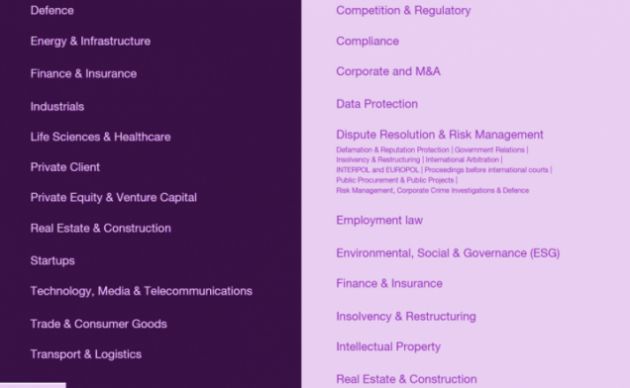Professional services firms nowadays offer more than what their respective categories imply. It isn’t uncommon for a law firm to offer tax compliance or audit services. Many accounting firms have expanded their service offerings to non-attorney legal work. Architectural firms are eager to provide civil engineering services; PR firms do websites; web dev shops offer social media marketing. The lines between categories continue to blur, and it isn’t obvious whether this is either a good or a bad thing.
As a typical firm grows in employee count and revenue the tendency becomes not only to expand on the variety of service offerings but to include services that used to be uncommon to the category.
The primary reasoning behind expanding the scope of capabilities seems to sprout from the conviction that this is what clients want. Management think that a one-stop shop is a good idea because it must be convenient for clients to get most of their needs met at one place.
Apart from that, some equity partners indulge themselves in (occasional) daydreaming about the following: if their personal income is $500,000 per partner with 25 people employed today, by doubling the head count they would, therefore, double their income — a very very unlikely scenario. The necessity for broader capabilities often stems from staff expansion.
Another contributing factor is emulation. The largest firms in the marketplace often serve as a beacon for imitation. Principals look up to these firms and reason that since those firms offer such a broad range of services it must be what the market wants; therefore, it must be how they themselves should conduct business as well.
Let’s not also dismiss the fact that a list of services and expertise that looks just like the market leaders’ flatters our self-esteem — another subtle reason.
In effect, through aspiring imitation, firms inevitably position themselves in direct competition not only with “the big guys” but also with those other firms that follow the same logic.
As a result firms make a long roster of all their capabilities and put it on display via their marketing channels: website, brochures, publications, listings, social media, etc. This signals potential buyers: we are just like those other big firms.
If we can provide everything offered by everyone else (including the biggest players) — managing partners think — surely this will convince buyers to include us in the consideration stage of the buying process; we’ll get to that RFP.
The wider we cast the net the more chances to fry a bigger fish.
Buyers, however, get a different gist of it: “Your long list of capabilities proves that you have no particular interest in what we are trying to buy.”
Buyer clash similar vendors
Consider your target market for a moment.
Buyers of professional services can be distinguished by their relationship to the service provider. There is a distinction between an existing client, a former client, a referral prospect, an inbound lead and an outbound contact.
Buyers who’ve already worked with your firm know what to expect and (hopefully) trust you more than any of your direct competitors. Other buyers are on the trust-diminishing spectrum.
Prospects that approach your firm through referrals have fewer of their spider-senses tingling. Everyone else is less inclined to trust any of your marketing speak. Those who’ve had no prior relationship with your firm, looking at how your service offerings perfectly match those of your competitors, to them you’re just another vendor — totally replaceable.

When your firm puts a billboard-size sign that says: “We (also) do everything X”, for non-clients and some referrals that’s an invitation to shop around. The more firms declare similar capabilities the more sense it makes to clash competitors head-on squeezing maximum value at minimal cost.
As your firm grows and develops more capabilities it feels natural to want to parade them. The more of your competitors do the same, however, the more obvious it is for your non-clients to perceive such sellers as interchangeable firms. For you this means: standardized RFP process, hourly rate comparisons, discount demands, scope creep, lower realization rates, lower profits margins.
Stop boasting all of your capabilities
“Okay, we’ll focus on cross-selling existing clients and on referrals then.”
This often works; although there are a few points to consider: for various reasons, cross-selling doesn’t always work well; existing client retention has its limits; word of mouth, although very effective, is totally out of your control.
You might want to pay attention to buyers outside your existing client pool and unpredictable referrals. Those buyers, however, will investigate their options prior to reaching out. They will familiarize themselves with your competition and they will form an opinion about who’s capable of what, and how it fits their requirements.
What buyers of professional services prefer is to hire a firm that understands their situation-specific challenges, not someone who can do everything X in general.
Therefore my suggestion is to abolish this practice of listing all of your capabilities front and center. Especially the basic-tier ones. Especially if your direct competitors keep doing this.
Managing partners often argue: “What would our clients think/say if we remove our service X from our website?”
First of all, there are ways to leave the service offering on the website. It makes sense to keep it for SEO purposes, and to be able to occasionally direct an interested party to the specific url. My concern is with placing the whole tapestry of services, that mirrors the competition, on a pedestal.
Second, your existing clients don’t visit your firm’s website as often as you might think they do; actually they almost certainly don’t visit it at all — why would they? They already know your firm, they believe they know what you can do; when there is no compelling reason to type your domain name, they won’t do it.
Getting rid of most of the service offerings on your website won’t change a thing with regard to your existing clients.
Please note, there is a distinction between not broadcasting a specific service and not providing the service. The fact that you haven’t listed capability X on your (e.g.) website doesn’t mean you won’t provide this service to your clients.
The point of displaying capabilities
Your existing clients will continue buying your service regardless of its absence or presence on your (e.g.) website. Referrals will be aware of your specific capability regardless of it being publicly advertised. They might look at your website — yes - but it won’t change much if they don’t find the service listed there.
Should you decide to remove an overwhelmingly long list of service offerings, especially the basic-tier ones, you will inevitably ponder: what should be placed front and center then? The answer depends on your differentiated business strategy, of course.
The public-facing information about your capabilities should primarily target the kind of clients you’ve decided to work with — not everyone in need of everything X. When you are strategic about the kind of work you want your people to get involved in, newly acquired clients will get to know you for doing that specific kind of work. Referrals will follow suit.
However, if you continue to promote, advertise, or otherwise parade your basic-tier, often commoditized, services, this will attract the kind of buyers that you might not necessarily want for your firm. If you accept them as new clients they will eventually refer other clients of the same caliber, reinforcing the feedback loop of low-tier services.
Indicators hinting at fungibility
Is there currently a problem at your firm? Here are some indicators that might suggest your service offerings are too broad, too generic or even commoditized:
- the market hasn’t shrunk but you are getting less RFPs;
- your proposal win rate is on decline, if it’s less than 38% — you’re in trouble;
- you are discounting more and more often, and the average discount is already above 20%.
If you’re experiencing price pressure from your existing clients and your win-to-bid rate is on decline that is a likely sign your services are perceived as a fungible commodity. Left unattended, your client base will start shifting toward less expertise-demanding buyers, your profit margins will start to decline, and your best talent will rush to update their résumés.
There are several ways how to tackle this problem. Contact me if you would like to know more.
The awezzom question of the day:
Have we become less attractive to buyers despite our broad capabilities?

